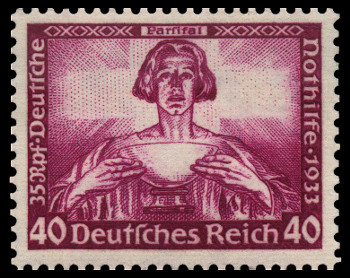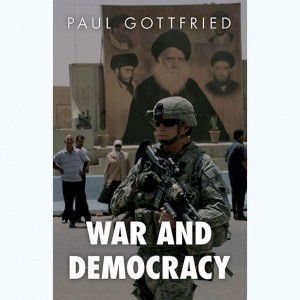
Charles Krafft, “NVA Dinner Set,” 2012
2,022 words
Übersetzt von Auziwandilaz
Literatur: Harold Covington
Lassen wir die politische Plausibilität oder den post-historischen Wahrheitsgehalt von Covingtons Romanen, die vom weißen Unabhängigkeitskrieg zu Beginn des 21. Jahrhunderts im pazifischen Nordwesten handeln, beiseite. Was wichtig ist, aus Covingtons Prosa herausgehoben zu werden, ist seine Sprache, seine Fähigkeit sowohl reale als auch surreale Plots zu konstruieren, und darüber hinaus all seine Befähigung eine gute Dosis Empathie mit seinen diversen Charakteren darzureichen.
Und in der Tat ist da eine vollständige Galerie diverser Charaktere in seinen Romanen – von entrechteten armen Weißen aus dem Süden, die einst Opfer einer positiven Diskriminierung wurden und die nun im umkämpften Nordwesten gelandet sind, zu protzigen und sie ausverkaufenden WASP-Politikern in DC, die darum wetteifern jüdischer als die Juden selbst zu sein. Jeder seiner zahlreichen Charaktere ist sorgfältig in seinen eigenen zeitlichen Rahmen eingepaßt, jeder trägt sein eigenes Bündel widersprüchlicher Erinnerungen, die sie oft bis ans Ende ihres Lebens heimsuchen. Covington, so sehr er die Denkweisen seiner gegensätzlichen Helden seziert, untersucht nicht nur deren selbstverkündetes rassisches Bewußtsein, sondern konzentriert sich stattdessen auf ihr Geschichtsbewußtsein. Der Leser wird keinen Charakter finden, der „White Power“ plärrt oder Hakenkreuze zur Schau trägt, oder endlos über die ominösen Juden debattiert. Die zahlreichen Monologe seiner Charaktere bezeugen, daß ihre persönlichen Erinnerungen selten angenehm sind. Sogar in der unverdorbenen Umgebung der Nordwestrepublik sind die Einwohner in ihr eigenes Dilemma des Seins oder Nichtseins versunken. In den meisten Fällen ist das rassische Bewußtsein von Covingtons Charakteren verbunden mit ihrer Rückerinnerung an die unvergesslichen Zeiten vergangener Zeitalter. Dementsprechend, in seinem jüngsten Roman „Freedom´s Sons“ der die aufkommende Nordwest-Republik schildert, treffen wir auf einen Mann, der als einer der Chefs der nordwestlichen Geheimpolizei Dienst tut. Doch dieser Mann hat auch eine Vergangenheit; er ist nicht gerade ein leeres weißes Blatt. Seine Großeltern flohen in der fernen Mitte des 20. Jahrhunderts aus der kommunistischen Tschechoslowakei und siedelten sich in der City von Chicago an – nur um eine andere Form des paleo-kommunistischen aka liberalen Irrsinns zu entdecken. Ihre Nachkommenschaft, die zukünftigen Siedler des Nordwestens, erkannten, daß sie in dem Land der Freien und der Heimat der Tapferen nicht nur einfach Subjekte des Terrors der „Affirmative Action“ waren, sondern ebenso Opfer von ständig wiederkehrenden Einbrüchen und zügellosem schwarzen Verbrechen. Letztendlich entschieden sie sich, nach langem Aufschieben, in den Nordwesten zu ziehen, auf ihrem Weg sowohl auf physische, als auch psychologische Sperren treffend, die auf vielfältige Art und Weise die schlimme Lage reflektiert, der sie einst im kommunistischen Europa begegneten.
Die Stärke von Covingtons Dichtkunst liegt in seiner Fähigkeit, menschliche Illusionen und das Wunschdenken über die geradlinige Entwicklung des Lebens zu zerstören, was eine tragende Säule der liberalen Schulweisheit zu sein scheint. In diesem Sinne sind Covingtons Romane nicht nur erdachte Geschichten, die von Weißen handeln, die mit Schußwaffen herumballern, sondern auch philosophische Schatzkammern, die „Slow-Coming-Dark“-Szenen mit unvorstellbaren Katastrophen ankündigen, wie sie alle weißen Leute im modernen Amerika zu erwarten haben. Die meisten seiner Charaktere, sowohl die weißen „guten Kerle“, als auch die nichtweißen „bösen Kerle“, sind tragische Figuren, die trotz der computerisierten Umwelt, in der sie leben, sich alle ihrer auf beiden Seiten exklusiven rassischen Vorherbestimmtheit sehr wohl bewußt sind.
Der Stil und die Geschichte können oft eine Menge über den Autoren selbst erzählen. Covington ist ein Meister der englischen Sprache. Er streut erfolgreich Slang-Ausdrücke in seine Dialoge, welche von schwarzen oder hispanischen Charakteren verwendet werden, wie zum Beispiel, als er knapp das Höllenloch des südlichen Los Angeles, nahe Compton, schildert. Er erfaßt auch die Gewandtheit der englischen Sprache, wenn er den Dialog zwischen gebildeten Weißen, die sich in einem sicheren Haus in der Nähe von Portland verbergen, beschreibt. Covington ist schon mehr als locker beim Beschreiben der urzeitlichen Impulse eines „Cholos“ aus Kalifornien, oder des impulsiven Verhaltens eines schwarzen „Gangstas“, der plant, wie er freie Fahrt auf Kosten der Gutgläubigkeit des weißen Mannes bekommen kann. Genauso leicht verbindet er den gestelzten Juristenjargon, den die herrschende Klasse in Washington DC benutzt, der sowohl in der Öffentlichkeit die Doktrin der rassischen Verschiedenartigkeit verteidigt, klugerweise jedoch im Privaten die Gesellschaft Nichtweißer meidet, dabei jedoch immer die öffentliche Unverfrorenheit („Chutzpah“) der alles beherrschenden Juden fürchtend.
Obwohl Covington sich sehr gut des tiefen und schicksalhaften, entscheidenden Faktors der Rasse bewußt ist, erkennen seine weißen Helden, daß die Einstellung zur Rassenzugehörigkeit – oder das, was man akademisch „Ansichten innerhalb von Gruppen“ („ingroup sentiments“) nennt – viel intensiver unter Nichtweißen, als unter Weißen ausgesprochen wird. So sehr hat sich der Prozeß des Selbsthasses in die Ansichten der neuzeitlichen Weißen in einem neuzeitlichen „Amurrica“ eingebrannt, daß in den meisten Fällen viele dessen von Natur aus guten Weißen ihr Selbstmord-Ritual des Selbsthasses als selbstverständlich ansehen. Sehr bezeichnend ist seine Beschreibung einer Mestizo-Lady, einer hochrangigen Bundespolizistin, deren Job darin besteht, weiße Separatisten in die Pfanne zu hauen, nichtsdestotrotz jedoch ausschließlich die Gesellschaft ihrer weißen Vorgesetzten genießt und sich ausschließlich auf sexuelle Begegnungen mit ihren weißen Bundes-Bossen einläßt.
Derartige Passagen einer rassischen Innenansicht verschiedenartiger Charaktere sind viel instruktiver beim Studium der Rassenpsychologie, als die kompletten Werke von Rassenpsychologen, wie Julius Evola oder Ludwig Claus.
Metapolitik, Seelenwanderung, Metaphysik
Gerade so, wie ein Leser versucht sein könnte Covington als einen guten Verfasser von Dichtung zu kategorisieren, welche von einem apokalyptischen, neuzeitlichen Amerika handelt, kann er genauso ein Meister des historischen Diskurses, durchaus in der Tradition eines Walter Scott oder Leo Tolstoi, genannt werden. Während es für einen Autoren relativ leicht sein kann einen Roman, der in der Zukunft spielt, zusammen zu stellen, auch mit all dem dazugehörigen High-Tech-Zubehör, wie wir es oft in einer großen Anzahl an Science-Fiction-Büchern finden (und welches sogar gelegentlich in Covingtons Kriegsromanen entdeckt werden kann), ist es weit schwieriger, einen Romanentwurf mit einem eindeutigen historischen Thema zu erstellen, ganz zu schweigen von der Sprache und dem Geruch des politischen Klimas einer verblichenen Ära. Covingtons Kunstfertigkeit im Schreiben historischer Romane liegt in seiner Befähigung, sich selbst jenseits des gegenwärtigen Zeitrahmens zu projizieren, wie in eine vorweggenommene Zukunft und wie auch jenseits der Zeitsequenzen der Vergangenheit. Diese Besonderheit seines Werkes wurde oft von seinen Kritikern außer Acht gelassen.
Covington benutzt eine dreigleisige Analyse beim Studieren seiner Charaktere: Metapolitik, Seelenwanderung und Metaphysik. Sein Werk ist insofern metapolitisch, als seine historischen Romane eine gute Beschreibung der Kräfte theologischen Wahns, die im England des 15. und 16. Jahrhunderts aufschienen, bieten, sowie, wie dieser Massenglauben die Politik dieser Zeit veränderte. In der Tat, wenn ein Leser wünscht, die Psychopathologie der marxistischen Mystik und deren 20. Jahrhundert-Armeen an treuherzigen Gläubigen innerhalb der westlichen akademischen Welt besser zu verstehen, kann Covingtons Schlüsselroman „The Black Flame“ hilfreich sein.
Die Handlung dieser Novelle spielt im 15. Jahrhundert-England, das zu der Zeit noch in den Hundertjährigen Krieg mit dem Königreich Frankreich involviert war. Alle Arten verschrobener Kulte verbreiteten sich über ganz England und ganz Europa, jeder für sich behauptend, daß der Tag des Jüngsten Gerichtes an der Türschwelle stehe, jedem sein theologisches Heilswerkzeug für die geistige Errettung anbietend. Der Hauptheld des Romans, ein englischer Kriminalbeamter irischer Abstammung, gesandt vom englischen Königshaus, untersucht die als „Black Flame“ bekannte Sekte, irgendwo in einem desolaten Teil Ost-Englands. Das Gerücht hatte sich verbreitet, daß diese Sekte in die Praktiken des Ritualmordes sowie in Ausschweifungen involviert sei. Wenn man die Geschichte dieses Buches auf unsere eigene Zeit anwendet, sendet sie implizit eine warnende Botschaft an die heutzutage durchgeknallten und selbsternannten Verrückten, die oft mit ihrem Weiß-Sein die Ausübung des Satanismus und kriminelles Verhalten sich vorstellen, dabei normale weiße Leute erschrecken und bei ihren Mitmenschen irreparablen Schaden anrichten. Daher, bevor ein Schüler oder ein weißer Aktivist mit dem Lesen akademischer Arbeiten über Rassenpsychologie anfängt, wie etwa mit den Werken eines weithin bekannten Gelehrten der Psychologie der Massen, Gustav le Bon, kann der Roman als eine gute Einführungsliteratur dienen.
Covingtons Denkansatz ist insofern auch metaphysisch, wie sein bestes Buch „Other Voices Darker Rooms“, das eine Sammlung historischer Novellen beinhaltet, die von dem tief bewegenden Thema der Zeit und des Daseins handeln und davon, wie die hauptsächlichen Charaktere dem Gefängnis des Zeitflusses, in den sie hineingeboren sind, zu entkommen versuchen. Obwohl das Buch auf den ersten Blick hin leicht lesbar erscheint, verlangt ein besseres Verständnis, daß es zweimal zu lesen ist, nicht zuletzt deshalb, weil es einen großen Teil eines wechselndenden Sybolismus, verbunden mit unterschiedlichen reinkarnierten Helden, von denen jeder innerhalb seines eigenen spezifischen historischen Zeitrahmens handelt, beinhaltet. Sehr wenige Autoren, sowohl vergangene als gegenwärtige, haben so eine große Menge Aufwand an Forschung und Reisen, ebenso an Charakteranalyse, erbracht, wie es Covington tat. Covington fängt in seinen historischen Romanen nicht nur den Geist der Zeit einer bestimmten historischen Epoche ein, sondern er forscht auch nach detaillierten Beschreibungen der Kleidung der Charaktere, nach ihrer Sprache und vor allem nach ihren historischen Erinnerungen. Im Gegensatz zu vielen Gelehrten und weißen Aktivisten erkennt Covington, daß das Weiß-Sein seine Benennung als dieses und seine historische Heimstätte haben muß; seine hauptsächlichen Helden, oder sogar auch seine Gegenhelden im sterbenden amerikanischen System, sind sich ihrer entfernten Südstaaten-weißen, polnischen, irischen, deutschen, schwarzen oder jüdischen Wurzeln bewußt. Selten reden seine weißen Helden wirr über abstraktes Weiß-Sein. Sie alle zeigen ein todernstes Bewußtsein des kraftvollen Einflusses ihrer kollektiven Erinnerung.
Gegenwärtig kann man Covingtons historische Romane unter der Bezeichnung „transhistorisch“ katalogisieren, indem seine Hauptcharaktere ständig die Zeitmauer zu durchbrechen wünschen. Daher kann man Covingtons Werk annähernd in dasselbe Fach wie die Werke des Howard P. Lovecraft, Ernst Jünger oder Aldous Huxley einsortieren, jener drei Autoren, die oft „Traditionalist“, „Reaktionär“ oder „Konservativer“ genannt werden. Sie alle streben danach den Fluß der Zeit anzuhalten, im Wunsch, den Sand der Zeit zurück laufen zu lassen – zumindest für den Bruchteil einer kosmischen Sekunde.
Covington und die Zeitmauer
Covington kann am besten die Psychologie der jüdischen „Stetl“-Bewohner im östlichen Galizien, das sich heute im östlichen Polen und der westlichen Ukraine befindet, nach dem jämmerlichen Rückzug der napoleonischen Armee aus Rußland Ende 1812, beschreiben. Die Haupthelden seiner Novelle „Whisper her Name on the Wind“ sind eine junge jüdische Lady und ein Anführer der Kosaken. Die französischen Armeen waren abgezogen, als plötzlich in das Stetl die gefürchteten Reiter der Kosaken einreiten, ein furchtloses, kriegerisches slawisches Volk, das traditionell als die Prätorianer-Garde des russischen Zaren gedient hat und die einen historische Ruf wegen ihres extremen Hasses auf die Juden hatten. Und natürlich auch andersherum. In seinen Romanen ergeht sich, wie auch immer, Covington nicht in wiederholten Schwarz-Weiß-Beleidigungen der Juden durch die Gojim, noch speit er Wörter, wie „kikes“, „yids“, „hebes“, „youtres“, „youpins“, „Saujuden“, „chifut“, „zhid“, „zhidov“ etc. aus – Wörter die, da kann man sicher sein, sich im täglichen (obwohl strikt privaten) Bewußtsein aller weißen Bürger Europas und Amerikas befinden. Stattdessen sieht er auf die Grauschattierungen dazwischen, wenn er seine guten, bösen und häßlichen Charaktere schildert. Hier begegnen wir einem couragierten jüdischen Mädchen von noblem Charakter, die ihre Kleinstadt vor dem Pogrom der Kosaken beschützen will, sogar nachdem die Kosaken gerade herausgefunden hatten, daß der jüdische Bürgermeister über vom Schatz des Zaren gestohlenes Gold gelogen hat. Für ihre Ehrenhaftigkeit und ihre Tapferkeit beim Abschließen eines Handels mit den kurz vor dem Abzug stehenden Kosakentruppen, wurde die junge jüdische Lady von ihren Stammesgenossen zu Tode gesteinigt. Man könnte fast sagen, daß diese von ihren Stammesgenossen getötete junge jüdische Lady der biblischen Esther gleicht – wenn auch in einer umgekehrten Rolle. Sie hatte die goldenen Regeln ihres Stammes gebrochen.
Die Stärke der Novelle liegt in ihrer akuraten Beschreibung der Kleidung und des Verhaltens der wilden Kosakenkrieger und ihres Hauptmannes, eines kultivierten und ehrenhaften Gentlemans, der ganz auf der Linie der alten Familientradition der Kosaken, sein heiliges Ehrenwort hält. Trotzdem, als er herausfindet, daß die junge jüdische Lady durch ihre eigenen Leute feige ermordet wurde, befiehlt er seinen Leuten ein Massaker an allen Juden der Stadt durchzuführen.
Covington hätte keine Chance, eine Fortsetzung dieser Novelle zu schreiben, eine Fortsetzung, die sich gänzlich jenseits einer grundverschiedenen Zeitmauer zutragen würde. Hundertunddreißig Jahre später, im späten Frühling 1945, ergaben sich mehr als eine Million antikommunistische Weiße russische Soldaten und 50.000 Kossaken, die auf deutscher Seite gekämpft hatten, den Westalliierten, da wo heute das nordöstliche Österreich ist. Zusammen mit ihren Familien wurden sie zurückgeschickt und den schnell erschienenen Sowjet-Kommissaren übergeben. Es ist wohl nicht nötig, ihr Schicksal zu beschreiben.
Original: Tom Sunic, “What to read?” (Part 2) The Occidental Observer, April 23, 2012







